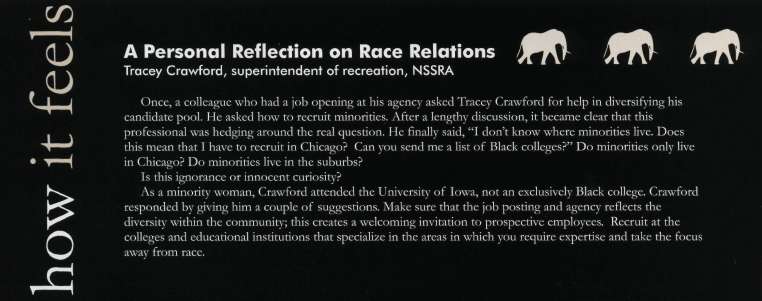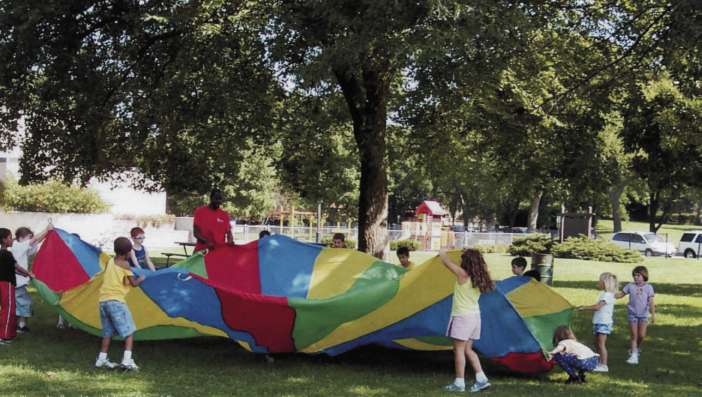 |
Home | Search | Browse | About IPO | Staff | Links |
 |
Home | Search | Browse | About IPO | Staff | Links |
September/October 2006 page 50 and 51
Gone are the days when people refused to work or eat at the same lunch counter with a person of another race (laws against discrimination have had their impact). But discrimination is still insidiously embedded in the routines and structures of our lives. Take, for example, the response to Hurricane Katrina. Most of the television images that showed people suffering showed people who were African American. Presumably, most of the people who were white had the resources to get out. The poor, who are disproportionately black, did not. Closer to home, according to Education Week's annual "Quality Counts," survey, since 2001 the public education system in Illinois has had the poorest grade of all 50 states for equity in school funding. That funding also skews along racial divides. Even in our play, we do not always play fair. Up until 1990, people of color could not become members of some of the country clubs that hosted stops on the PGA tour. Unfortunately, our public park and recreation agencies, which are, after all, reflections of the larger society, have not been able to stop that undercurrent of discrimination. Maybe we feel that we cannot single handedly overcome the vestiges of a history of sometimes overt and sometimes violent racial, religious and socioeconomic discrimination in America. But, as people who govern and manage our park, recreation and conservation agencies, we can determine within ourselves and our agencies just how inclusive and welcoming we actually are. If we take a hard, unblinking look, we can begin to understand the frustration of people who are minorities. And then we can in our agencies — our own small part of the society — create a more culturally inclusive atmosphere. This is not something we ought to do. This is something we need to do. According to the U.S. Census Bureau, by 2050 white Americans will be less than 50 percent of the total U.S. population. As a profession, are we ready for this future? Why Discrimination Still HappensMost of us seek the familiar and comfortable. And nothing is more comfortable than being with, living with and recreating with people most like ourselves. Consequently, the communities your agency serves are sometimes self-segregated. Many of us believe that our way of being or thinking or even of recreational programming is the best way, the right way or even the only way. But it is not. For example, in March 2005 Jon McChesney, Michelle Gerken and Kelly McDonald published an article in Parks & Recreation magazine on attracting more people who are Hispanic to park and recreation agencies. They reported on lessons that many agencies learned the hard way. It seems attracting more people who are Hispanic minorities is not simply a matter of translating the seasonal brochure into Spanish. Rather, attracting this segment of the population requires an understanding that "Hispanic recreation follows cultural traditions that make nature and family oriented activities popular. Hispanics, in general, enjoy the 'gathering' type of activities versus the organized type of activity that characterizes much of the recreation landscape." We need to recognize that we can no longer throw out the balls and expect people to be comfortable, play and have fun. In fact, by doing so, we may be making the situation more uncomfortable. As a minority, I can tell you, that we — people of color or people who are non-Christian or otherwise different — are taught to assimilate, or act white, be white, because sometimes  September/October 2006 page 52
people who have successfully assimilated feel they are allowed "in." In doing so, we must, on some level, at least pretend to buy into the notion that it is best to be white, just like most of the power holders and decision-makers we see all around us. This "buy-in" forces us to deny who we really are, which never feels good. And it is exhausting "being white," since we never really are. Are we, as providers of park and recreation opportunities, sending the message (even unintentionally) that it is better to be white, or straight or Christian? In our programs, do we have a prayer before a "big game" or sing "God Bless America?" (Why not "This Land is Your Land" instead? What is wrong with the "Star Spangled Banner?") Do we make rules that "members only" can take swimming lessons? Do we establish dress codes that do not accommodate, for example, the Brownie troupe of Muslim girls who may not swim in the pool at the same time the boys do? We need to open ourselves to new perspectives so that all the people of our communities can feel welcome, relaxed and truly free to recreate. Today, too many people still distrust, question and discriminate against unfamiliar people who are a different color, different religion, different ethnicity, different sexual orientation. One solution is to become familiar with other people, their cultures, their belief of what is good, accepting who they (all the "they"s) are without attempting to remake them into white Christians. A place to start that process is in the gyms, the preschools, the dance classes and ladies' 50 and over softball programs offered at our park and recreation agencies. Then perhaps we can start to get rid of racial and religious intolerance in other parts of our society as well. Recognizing Inequity at Your AgencyOnce we recognize that discrimination exists, the next steps are a bit easier. Look at your agency. Are you welcoming of diversity or do you inadvertently keep people who are different away? Find the racial and ethnic demographics of the communities you serve. Then determine
September/October 2006 page 53 the racial and ethnic diversity of the people who participate in your programs. Do the percentages match? If not, perhaps people who are under-represented do not feel comfortable at your facilities. Or, perhaps, you have a gap in your program offerings. Look at your board, your administration and your staff. How does that racial, ethnic, religious and socioeconomic mix compare to that of your community? It should match. But that will not be easy to remedy overnight. It has been brought to us — people who are minorities — that it is difficult to find qualified minorities for recreation positions. There are few qualified applicants, and the people who are qualified have their choice of agencies. Perhaps the question is why do so few people who are minorities come into the recreation profession? What and how many barriers do people of color have to battle before earning a college degree? Has the recreation profession erected barriers, such as required full-time internships? It is difficult to complete a full-time internship when students must work other jobs to support themselves or their families. People who are minorities do not want a career where they have felt unwelcome. Perhaps our strategy should be to welcome people who are minorities as patrons first, and then let their passion lead them into the profession. Becoming a Welcoming AgencyHow can an agency become more welcoming? Start with a commitment to accepting or including all people no matter what. Let us open our minds to the possibility that there are other ways of doing, thinking, feeling and living. For example, maybe we do not need to exclude teenagers from programs because they arrive wearing their hair in purple mohawks, with rings in their noses, eyebrows and tongues. Maybe we do not run and gossip about or stare at the same sex couple that is holding hands while watching their child keep goal. Maybe it would be OK to let a child with underwear under her bathing suit — a custom with some people who are Hispanic — to go into the pool. After all, we will allow the bikini-clad teen who has been wearing her suit all day swim. Frequently those excluded are only looking for acceptance and the ability to participate. Once the park and recreation agency is committed to change, the following actions can assist in making it welcoming to all. • Acknowledge that discrimination and intolerance exist in your community. They exist in all communities. All communities are different and diversity issues must be specifically addressed in each community. • Look for discrimination and unnecessary value judgments in policies, procedures, daily routines, structures, the layout of rooms, posters, displays, etc. Is there anything that is unwelcoming to people of different races, different ethnic September/October 2006 page 54
 September/October 2006 page 55 groups, different religions, different abilities, different family configurations and different sexual orientations? • Change to become more welcoming of all. Incorporate the welcoming spirit in the mission, vision, goals and objectives of the agency and keep going until all programs reflect this spirit. Ask a diverse group of citizens to assist in identifying anything unwelcoming and to help change it to be welcoming and accepting. (For more assistance, see the article from Diversitylnc. Key Findings From The 2006 Top 50 Companies for Diversity on Corporate America summarized on page 55.) • Form a diversity advisory board. Involve diverse community members in identifying unwelcoming issues and value judgments, planning and developing programs and training on diversity. • Educate continuously, not just on diversity days or during orientation. Train all staff and board members in acceptance of all. • Interweave the welcoming spirit into daily and yearly routines. For example, each December many agencies already have winter programs that incorporate celebrations from other cultures. Why not find a way to infuse this recognition of other cultures in our programs throughout the year? Ask people of diverse backgrounds to come to other scheduled activities to share customs from their cultures. Or, add a section in your brochure highlighting customs from diverse cultures. You may even develop programs that focus on learning about different cultures from around the world. • Expect that diverse community members do not know how: how to play a game; how go swimming; how to change in the locker room or use the lockers; how to register for a program. Maybe it is difficult for a newcomer -especially one from a different culture — to know what equipment to bring or where to go. Look at everything as if you were an alien, and then train your staff to assist you. Changing people's minds is a slow process and involves education and understanding of others' feelings and customs. But we can only achieve results when we acknowledge — and deal with — the elephant in the recreation center. Then we can work toward creating agencies where people of all races, ethnicities, income levels and sexual orientations can relax and play together. Isn't that what we want? Gail H. Ito, MS, CTRS is an assistant professor in the recreation program of the Health, Physical Education and Recreation Department (HPER) at Chicago State University. She is currently completing her Ed D. at Northern Illinois University in adult and higher education. Prior to teaching, she worked in the recreation field for more than 20 years as a Certified Therapeutic Recreation Specialist. In her spare time, she is the chairperson of the Lincolnwood Parks and Recreation Advisory Board. She still manages to find time to enjoy her kids' and husband's softball, soccer and basketball games; to camp; do a little dancing and play games. September/October 2006 page 56
www.ILparks.org September/October 2006 57 |Home|
|Search|
|Back to Periodicals Available|
|Table of Contents|
|Back to Illinois Parks and Recreation 2006|
|